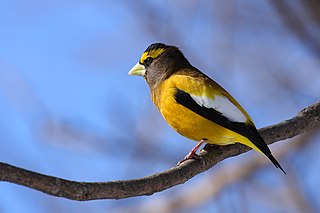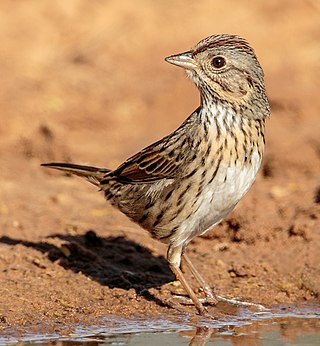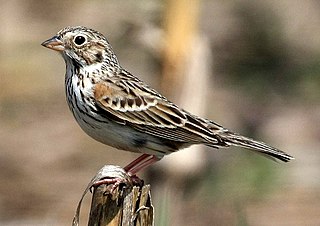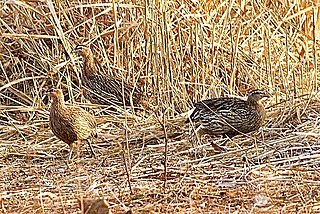
The white-throated sparrow is a passerine bird of the New World sparrow family Passerellidae. It breeds in northern North America and winters in the southern United States.

The dark-eyed junco is a species of junco, a group of small, grayish New World sparrows. The species is common across much of temperate North America and in summer it ranges far into the Arctic. It is a variable species, much like the related fox sparrow, and its systematics are still not completely resolved.

The American tree sparrow, also known as the winter sparrow, is a medium-sized New World sparrow.

The evening grosbeak is a passerine bird in the finch family Fringillidae found in North America.

The pine siskin is a North American bird in the finch family. It is a migratory bird with an extremely sporadic winter range.

The yellow-breasted bunting is a passerine bird in the bunting family Emberizidae that is found across the Boreal and East Palearctic. The genus name Emberiza is from Old German Embritz, a bunting. The specific aureola is Latin for "golden". The bird's call is a distinctive zick, and the song is a clear tru-tru, tri-tri.

Lincoln's sparrow is a small sparrow native to North America. It is a less common passerine bird that often stays hidden under thick ground cover, but can be distinguished by its sweet, wrenlike song. Lincoln's sparrow is one of three species in the genus Melospiza which also includes the song sparrow and the swamp sparrow. It lives in well-covered brushy habitats, often near water. This bird is poorly documented because of its secretive nature and breeding habits solely in boreal regions.

The vesper sparrow is a medium-sized New World sparrow. The only member of the genus Pooecetes, it is a pale sparrow with brown streaks that breeds across the grasslands of northern North America. It migrates to winter in the southern United States and Mexico.

The double-spurred spurfowl is a gamebird in the pheasant family Phasianidae of the order Galliformes, gallinaceous birds. Like most spurfowls, it is restricted to Africa. It is a resident breeder in tropical west Africa, but there is a small and declining isolated population in Morocco.

The yellow rail is a small secretive marsh bird of the family Rallidae that is found in North America.

The double-striped thick-knee is a stone-curlew, a group of waders in the family Burhinidae. The vernacular name refers to the prominent joints in the long greenish-grey legs, and bistriatus to the two stripes of the head pattern.

Baird's junco is a species of junco, a group of small, grayish New World sparrows. It is endemic to the forests in the higher elevations of the Sierra de la Laguna mountain range of the southern Baja California peninsula in Baja California Sur, Mexico.

The yellow-eyed junco is a species of junco, a group of small New World sparrows.

The golden-crowned sparrow is a large New World sparrow found in the western part of North America.

The handsome spurfowl is a species of bird in the pheasant family Phasianidae. It is a large, up to 35 cm long, terrestrial forest bird with a dark reddish brown plumage, grey head, red bill and legs, brown iris, bare red orbital skin and rufous grey below. Both sexes are similar. The female is slightly smaller than male. The young has duller plumage.

New World sparrows are a group of mainly New World passerine birds, forming the family Passerellidae. They are seed-eating birds with conical bills, brown or gray in color, and many species have distinctive head patterns.

The red-billed spurfowl, also known as the red-billed francolin, is a species of bird in the family Phasianidae. It is found in Southern Africa, including Angola, Botswana, Namibia, South Africa, Zambia, and Zimbabwe.

Erckel's spurfowl, also known as Erckel's francolin, is a species of game bird in the family Phasianidae.

Atlapetes is a genus of birds in the New World sparrow family Passerellidae. The species are mainly found in montane forest from Mexico to northwestern Argentina.

The Vanuatu white-eye or yellow-fronted white-eye is a small passerine bird belonging to the genus Zosterops in the white-eye family Zosteropidae. It is endemic to Vanuatu, where it is one of the most common birds.


























